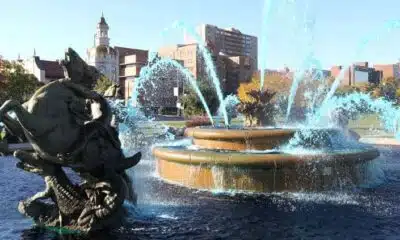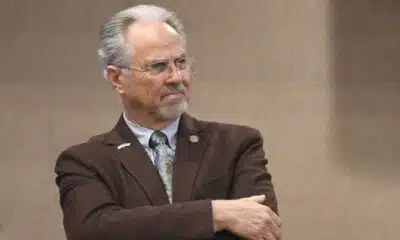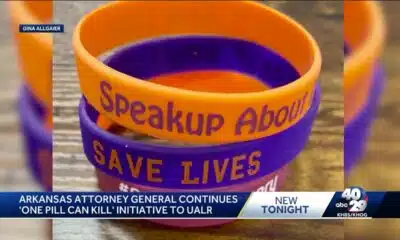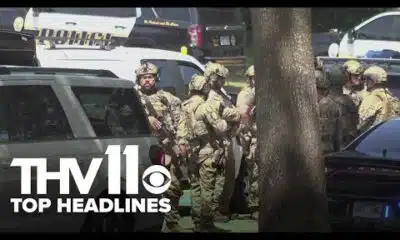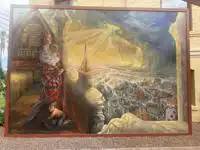Mississippi Today
Farm conservation programs offer solutions to climate threats, but are vastly underfunded

When the U.S. Department of Agriculture denied Albert Johnson Sr.’s application for a farm loan in the mid-1980s, he went to a private lender who made him list as collateral all 20 of his cattle and his one bull.
“I stood a chance of losing my livestock,” Johnson wrote in a 1999 affidavit to receive part of a $2.3 billion federal settlement between Black farmers and the USDA.
Johnson, 81, who lives near Lexington, Mississippi, was among thousands deemed to not qualify for settlement money, his family said.
Against all odds, their family farm has persisted, part of the just 1% of remaining Black-owned farms in the United States. In an age of mechanized and industrialized agriculture, they face many challenges in operating a sustainable cattle farm — and there’s federal assistance to help with that.
But last month, Johnson’s children learned their application for federal conservation funding was turned down. They had sought up to $30,000 to dig a well and add cross fencing that would have allowed them to do rotational cattle grazing, which protects the soil from erosion.

“It was like ‘here again, another generation’,” said Charlene Gatson, 50, Johnson’s daughter. ”It was like history repeating itself.”
The Biden administration has called such USDA conservation programs a “linchpin” in the nation’s climate strategy, yet they remain vastly underfunded.
Just three out of 10 landowner applications for the two main programs, the Environmental Quality and Incentives Program and the Conservation Stewardship Program, were approved between 2018 and 2022. The majority of landowners are told to try again without advice on how to improve their odds.
“These are farmers and landowners who want to do conservation on their farm. They want to do something we all seem to support — which is conserving natural resources,” said Jonathan Coppess, an associate professor and director of the Gardner Agriculture Policy Program at the University of Illinois.
Farmers want to improve the environment. Hundreds of thousands of them are applying. “And then you don’t get funding for no other reason than that funding is not sufficient in the program. The level of frustration and anger is pretty real,” said Coppess.
Although the Inflation Reduction Act provided $18 billion more for these in-demand conservation programs, some members of Congress want to claw back that money to pay for the 2023 Farm Bill.
High demand, not enough money
The flagship program of the USDA’s Natural Resources Conservation Service is the one the Johnsons applied for —the Environmental Quality Incentives Program — which reimburses agricultural and forestry producers 50% to 90% of the cost for fixing specific conservation problems and delivering environmental benefits, such as improving water or air quality, enriching soil or protecting against drought.
Between fiscal 2018 and fiscal 2022, the Resource Conservation Service allocated $6.2 billion for the program, but that only covered 31% of the nearly 600,000 applications submitted during that five-year period, according to Investigate Midwest’s analysis of application and funding data the USDA provided The Gazette as part of a Freedom of Information Act request.
The Conservation Stewardship Program, created in the 2008 Farm Bill, provides annual payments to producers willing to improve conservation over a five-year period. The Resources Conservation Service awarded $2.1 billion from fiscal 2018 through fiscal 2022, which covered just 28% of applications nationwide.
“EQIP and CSP are working lands programs so they are doing conservation on land that is continuing to produce crops,” Coppess said.
Programs face criticism, but remain the main federally supported solution
Modern agriculture takes a toll on soil and water. Programs like these are intended to mitigate the damage. A 2020 National Resource Conservation Service report showed the Environmental Quality Incentives Program’s conservation from 2014-2018 increased soil and carbon retained in farm fields as well as provided wildlife habitat.
“Practices funded through EQIP to address forest health and watershed protection on non-industrial private forest land also sequester carbon,” the report found.
The most popular requests for the two programs’ funds vary by state. In Iowa and Wisconsin, where corn and soybeans grow, cover crops were by far the most-funded environmental incentives program practice from 2017 through 2020, according to an analysis from the Environmental Working Group. But in Mississippi, with a more diverse farming mix including poultry, livestock and cotton, the environmental incentives program’s practices that got the most funding were for fencing, grade stabilization structures and irrigation.
Some environmental groups have criticized that program for earmarking 50% of all funding for livestock practices, Coppess said. Although the U.S. has the world’s largest fed-cattle industry and livestock make up half or more of some states’ ag exports, what if your state isn’t big into pork or beef? Does that mean you get less money? There also are fears it will encourage more large-scale animal production, which can produce large amounts of waste that threatens water sources.
The National Resource Conservation Service allocates money to each state for the environmental quality incentive and conservation stewardship programs contracts. States then distribute the cash to counties or manage the funds at the state level.
To decide how to spend the limited pot of money for conservation programming, local Resource Conservation Service officials rank applications on a handful of factors, including how much the practice or activity costs, the magnitude of environmental benefits that could be achieved and how well the practice or activity proposed fits with “national priority resource concerns,” the service reported.
“The ranking process was developed to try to be fair to everyone,” said Scott Cagle, assistant state conservationist for partnerships with the Iowa National Resource Conservation Service. But there are winners and losers and some producers drop out if they don’t get funded right away, Cagle said.
“We run into instances where producers signed up, the process takes too long sometimes and they give up,” he said.
Outreach to Black landowners, others who are underserved
The Johnson family is raising cattle on about 15 of the 200 acres they own near Lexington, Mississippi. During long spells without rain, the grass dries up and the Johnsons have to buy hay.

Then the pond dries up and they have to use a hose from the house to water the cows, Gatson said.
If they got Environmental Quality Incentive Program money, they would install cross fencing that would allow them to move cattle around, so plants can regrow between grazings and better protect the soil from erosion. A new well to provide reliable water would cost as much as $20,000.
“We need funding just for the cows to survive,” Gatson said.
The Mississippi National Resource Conservation Service suggested in a Oct. 6 denial letter that the Johnsons “defer” their program application, which puts it back in the pile for the next funding cycle. But Gatson wants to know why their project didn’t rank higher so she can improve the application for next time.
“Could you tell us why some were funded and some were not?” she asked.
National Resource Conservation Service offices across the country have been trying to staff up to provide faster distribution of funds and more help for applicants. A workload analysis for Mississippi’s service says they need another 55 to 60 employees to meet the need there.
Mississippi conservation officials have been expanding outreach to small producers, including those who haven’t traditionally gotten funding.
“If you look at Mississippi, it has the highest percentage of Black landowners in the nation and that’s around 10%,” said James Cummins, executive director of Wildlife Mississippi, a nonprofit that works toward habitat restoration and conservation policy in the state. “We want to see a percentage (of new conservation money) going to help historically-underserved producers to help them maintain their family’s land and improve their natural resources.”
Mississippi, a state where agriculture is the No. 1 industry, submitted a whopping 10% of all Environmental Quality Incentive Program and Conservation Stewardship Program applications from fiscal 2018 through fiscal 2022. But despite having the highest number of applications in both programs, only 14% of its stewardship program applications were approved, making it the state with the lowest approval rate relative to its application volume. In the case of environmental quality program, the state had an approval rate of just 21%.
Noemy Serrano is assistant policy director at Michael Fields Agricultural Institute who also works for Wisconsin Women in Conservation, which helps women farmers figure out conservation programs like National Resource Conservation Service. She said recently a farmer who’d received Environmental Quality Incentive Program funding before was confused about whether she could apply again.
“That speaks to the details,” Serrano said. “Even folks that have already applied and been funded through the program sometimes don’t fully understand how it works and how to move forward with it.”
According to USDA data, Wisconsin funded 37% of the environmental quality incentives applications and 35% of stewardship program applications received in fiscal year 2022.
In a perfect world, the National Resource Conservation Service would work with each farmer to make their application more likely to be funded, advocates said.
But because the service staff are so busy, “instead of going out and adding different projects to these applications…they’re not adding that on, because it means more work,” said Sara George, who grows specialty crops near Pepin, Wisconsin.
Cash infusion in jeopardy
Conservation advocates hope a federal cash infusion will reduce the backlog of unfunded projects.
The Inflation Reduction Act, signed by President Biden in August 2022, provides $8.45 billion more for the environmental quality program and $3.25 billion more for the stewardship program starting this year and building through fiscal 2026. This could potentially fund hundreds of thousands more applications. There’s another $300 million to quantify greenhouse gas sequestration.
“We know nationwide that IRA funds will increase” in 2024, said Jamie Alderks, assistant state conservationist for financial assistance programs with the Illinois National Resource Conservation Service. “IRA funds will assist in meeting some of the unmet demand.”
But Republicans in the U.S. House want to repurpose that the Inflation Reduction Act conservation money to help pay for the Farm Bill, which expired in October without being renewed. House Agriculture Chairman Glenn Thompson suggested cutting $50 billion, mostly to climate change and public nutrition programs, to pay for other agriculture programs, such as crop insurance, The Hill reported.
In an Oct. 23 letter published by Politico, 24 Democrats on the House Agriculture Committee pushed back against the idea: “Moving the IRA funds from conservation would be denying farmers the support they need and want.”
Brittney J. Miller of the Gazette contributed to this story, which is a product of the Mississippi River Basin Ag & Water Desk, an independent reporting network based at the University of Missouri in partnership with Report for America, with major funding from the Walton Family Foundation.
This article first appeared on Mississippi Today and is republished here under a Creative Commons license.
Mississippi Today
Presidents are taking longer to declare major natural disasters. For some, the wait is agonizing
TYLERTOWN — As an ominous storm approached Buddy Anthony’s one-story brick home, he took shelter in his new Ford F-250 pickup parked under a nearby carport.
Seconds later, a tornado tore apart Anthony’s home and damaged the truck while lifting it partly in the air. Anthony emerged unhurt. But he had to replace his vehicle with a used truck that became his home while waiting for President Donald Trump to issue a major disaster declaration so that federal money would be freed for individuals reeling from loss. That took weeks.
“You wake up in the truck and look out the windshield and see nothing. That’s hard. That’s hard to swallow,” Anthony said.
Disaster survivors are having to wait longer to get aid from the federal government, according to a new Associated Press analysis of decades of data. On average, it took less than two weeks for a governor’s request for a presidential disaster declaration to be granted in the 1990s and early 2000s. That rose to about three weeks during the past decade under presidents from both major parties. It’s taking more than a month, on average, during Trump’s current term, the AP found.
The delays mean individuals must wait to receive federal aid for daily living expenses, temporary lodging and home repairs. Delays in disaster declarations also can hamper recovery efforts by local officials uncertain whether they will receive federal reimbursement for cleaning up debris and rebuilding infrastructure. The AP collaborated with Mississippi Today and Mississippi Free Press on the effects of these delays for this report.
“The message that I get in the delay, particularly for the individual assistance, is that the federal government has turned its back on its own people,” said Bob Griffin, dean of the College of Emergency Preparedness, Homeland Security and Cybersecurity at the University at Albany in New York. “It’s a fundamental shift in the position of this country.”
The wait for disaster aid has grown as Trump remakes government
The Federal Emergency Management Agency often consults immediately with communities to coordinate their initial disaster response. But direct payments to individuals, nonprofits and local governments must wait for a major disaster declaration from the president, who first must receive a request from a state, territory or tribe. Major disaster declarations are intended only for the most damaging events that are beyond the resources of states and local governments.
Trump has approved more than two dozen major disaster declarations since taking office in January, with an average wait of almost 34 days after a request. That ranged from a one-day turnaround after July’s deadly flash flooding in Texas to a 67-day wait after a request for aid because of a Michigan ice storm. The average wait is up from a 24-day delay during his first term and is nearly four times as long as the average for former Republican President George H.W. Bush, whose term from 1989-1993 coincided with the implementation of a new federal law setting parameters for disaster determinations.
The delays have grown over time, regardless of the party in power. Former Democratic President Joe Biden, in his last year in office, averaged 26 days to declare major disasters — longer than any year under former Democratic President Barack Obama.

FEMA did not respond to the AP’s questions about what factors are contributing to the trend.
Others familiar with FEMA noted that its process for assessing and documenting natural disasters has become more complex over time. Disasters have also become more frequent and intense because of climate change, which is mostly caused by the burning of fuels such as gas, coal and oil.
The wait for disaster declarations has spiked as Trump’s administration undertakes an ambitious makeover of the federal government that has shed thousands of workers and reexamined the role of FEMA. A recently published letter from current and former FEMA employees warned the cuts could become debilitating if faced with a large-enough disaster. The letter also lamented that the Trump administration has stopped maintaining or removed long-term planning tools focused on extreme weather and disasters.
Shortly after taking office, Trump floated the idea of “getting rid” of FEMA, asserting: “It’s very bureaucratic, and it’s very slow.”
FEMA’s acting chief suggested more recently that states should shoulder more responsibility for disaster recovery, though FEMA thus far has continued to cover three-fourths of the costs of public assistance to local governments, as required under federal law. FEMA pays the full cost of its individual assistance.
Former FEMA Administrator Pete Gaynor, who served during Trump’s first term, said the delay in issuing major disaster declarations likely is related to a renewed focus on making sure the federal government isn’t paying for things state and local governments could handle.
“I think they’re probably giving those requests more scrutiny,” Gaynor said. “And I think it’s probably the right thing to do, because I think the (disaster) declaration process has become the ‘easy button’ for states.”
The Associated Press on Monday received a statement from White House spokeswoman Abigail Jackson in response to a question about why it is taking longer to issue major natural disaster declarations:
“President Trump provides a more thorough review of disaster declaration requests than any Administration has before him. Gone are the days of rubber stamping FEMA recommendations – that’s not a bug, that’s a feature. Under prior Administrations, FEMA’s outsized role created a bloated bureaucracy that disincentivized state investment in their own resilience. President Trump is committed to right-sizing the Federal government while empowering state and local governments by enabling them to better understand, plan for, and ultimately address the needs of their citizens. The Trump Administration has expeditiously provided assistance to disasters while ensuring taxpayer dollars are spent wisely to supplement state actions, not replace them.”

In Mississippi, frustration festered during wait for aid
The tornado that struck Anthony’s home in rural Tylertown on March 15 packed winds up to 140 mph. It was part of a powerful system that wrecked homes, businesses and lives across multiple states.
Mississippi’s governor requested a federal disaster declaration on April 1. Trump granted that request 50 days later, on May 21, while approving aid for both individuals and public entities.
On that same day, Trump also approved eight other major disaster declarations for storms, floods or fires in seven other states. In most cases, more than a month had passed since the request and about two months since the date of those disasters.
If a presidential declaration and federal money had come sooner, Anthony said he wouldn’t have needed to spend weeks sleeping in a truck before he could afford to rent the trailer where he is now living. His house was uninsured, Anthony said, and FEMA eventually gave him $30,000.
In nearby Jayess in Lawrence County, Dana Grimes had insurance but not enough to cover the full value of her damaged home. After the eventual federal declaration, Grimes said FEMA provided about $750 for emergency expenses, but she is now waiting for the agency to determine whether she can receive more.

“We couldn’t figure out why the president took so long to help people in this country,” Grimes said. “I just want to tie up strings and move on. But FEMA — I’m still fooling with FEMA.”
Jonathan Young said he gave up on applying for FEMA aid after the Tylertown tornado killed his 7-year-old son and destroyed their home. The process seemed too difficult, and federal officials wanted paperwork he didn’t have, Young said. He made ends meet by working for those cleaning up from the storm.
“It’s a therapy for me,” Young said, “to pick up the debris that took my son away from me.”
Historically, presidential disaster declarations containing individual assistance have been approved more quickly than those providing assistance only to public entities, according to the AP’s analysis. That remains the case under Trump, though declarations for both types are taking longer.
About half the major disaster declarations approved by Trump this year have included individual assistance.
Some people whose homes are damaged turn to shelters hosted by churches or local nonprofit organizations in the initial chaotic days after a disaster. Others stay with friends or family or go to a hotel, if they can afford it.
But some insist on staying in damaged homes, even if they are unsafe, said Chris Smith, who administered FEMA’s individual assistance division under three presidents from 2015-2022. If homes aren’t repaired properly, mold can grow, compounding the recovery challenges.

That’s why it’s critical for FEMA’s individual assistance to get approved quickly — ideally, within two weeks of a disaster, said Smith, who’s now a disaster consultant for governments and companies.
“You want to keep the people where they are living. You want to ensure those communities are going to continue to be viable and recover,” Smith said. “And the earlier that individual assistance can be delivered … the earlier recovery can start.”
In the periods waiting for declarations, the pressure falls on local officials and volunteers to care for victims and distribute supplies.
In Walthall County, where Tylertown is, insurance agent Les Lampton remembered watching the weather news as the first tornado missed his house by just an eighth of a mile. Lampton, who moonlights as a volunteer firefighter, navigated the collapsed trees in his yard and jumped into action. About 45 minutes later, the second tornado hit just a mile away.
“It was just chaos from there on out,” Lampton said.
Walthall County, with a population of about 14,000, hasn’t had a working tornado siren in about 30 years, Lampton said. He added there isn’t a public safe room in the area, although a lot of residents have ones in their home.
Rural areas with limited resources are hit hard by delays in receiving funds through FEMA’s public assistance program, which, unlike individual assistance, only reimburses local entities after their bills are paid. Long waits can stoke uncertainty and lead cost-conscious local officials to pause or scale-back their recovery efforts.

In Walthall County, officials initially spent about $700,000 cleaning up debris, then suspended the cleanup for more than a month because they couldn’t afford to spend more without assurance they would receive federal reimbursement, said county emergency manager Royce McKee. Meanwhile, rubble from splintered trees and shattered homes remained piled along the roadside, creating unsafe obstacles for motorists and habitat for snakes and rodents.
When it received the federal declaration, Walthall County took out a multimillion-dollar loan to pay contractors to resume the cleanup.
“We’re going to pay interest and pay that money back until FEMA pays us,” said Byran Martin, an elected county supervisor. “We’re hopeful that we’ll get some money by the first of the year, but people are telling us that it could be [longer].”
Lampton, who took after his father when he joined the volunteer firefighters 40 years ago, lauded the support of outside groups such as Cajun Navy, Eight Days of Hope, Samaritan’s Purse and others. That’s not to mention the neighbors who brought their own skid steers and power saws to help clear trees and other debris, he added.
“That’s the only thing that got us through this storm, neighbors helping neighbors,” Lampton said. “If we waited on the government, we were going to be in bad shape.”
Lieb reported from Jefferson City, Missouri, and Wildeman from Hartford, Connecticut.
Update 98/25: This story has been updated to include a White House statement released after publication.
This article first appeared on Mississippi Today and is republished here under a Creative Commons Attribution-NoDerivatives 4.0 International License.
The post Presidents are taking longer to declare major natural disasters. For some, the wait is agonizing appeared first on mississippitoday.org
Note: The following A.I. based commentary is not part of the original article, reproduced above, but is offered in the hopes that it will promote greater media literacy and critical thinking, by making any potential bias more visible to the reader –Staff Editor.
Political Bias Rating: Center-Left
This article presents a critical view of the Trump administration’s handling of disaster declarations, highlighting delays and their negative impacts on affected individuals and communities. It emphasizes concerns about government downsizing and reduced federal support, themes often associated with center-left perspectives that favor robust government intervention and social safety nets. However, it also includes statements from Trump administration officials defending their approach, providing some balance. Overall, the tone and framing lean slightly left of center without being overtly partisan.
Mississippi Today
Northeast Mississippi speaker and worm farmer played key role in Coast recovery after Hurricane Katrina
The 20th anniversary of Hurricane Katrina slamming the Mississippi Gulf Coast has come and gone, rightfully garnering considerable media attention.
But still undercovered in the 20th anniversary saga of the storm that made landfall on Aug. 29, 2005, and caused unprecedented destruction is the role that a worm farmer from northeast Mississippi played in helping to revitalize the Coast.
House Speaker Billy McCoy, who died in 2019, was a worm farmer from the Prentiss, not Alcorn County, side of Rienzi — about as far away from the Gulf Coast as one could be in Mississippi.
McCoy grew other crops, but a staple of his operations was worm farming.
Early after the storm, the House speaker made a point of touring the Coast and visiting as many of the House members who lived on the Coast as he could to check on them.
But it was his action in the forum he loved the most — the Mississippi House — that is credited with being key to the Coast’s recovery.
Gov. Haley Barbour had called a special session about a month after the storm to take up multiple issues related to Katrina and the Gulf Coast’s survival and revitalization. The issue that received the most attention was Barbour’s proposal to remove the requirement that the casinos on the Coast be floating in the Mississippi Sound.
Katrina wreaked havoc on the floating casinos, and many operators said they would not rebuild if their casinos had to be in the Gulf waters. That was a crucial issue since the casinos were a major economic engine on the Coast, employing an estimated 30,000 in direct and indirect jobs.
It is difficult to fathom now the controversy surrounding Barbour’s proposal to allow the casinos to locate on land next to the water. Mississippi’s casino industry that was birthed with the early 1990s legislation was still new and controversial.
Various religious groups and others had continued to fight and oppose the casino industry and had made opposition to the expansion of gambling a priority.
Opposition to casinos and expansion of casinos was believed to be especially strong in rural areas, like those found in McCoy’s beloved northeast Mississippi. It was many of those rural areas that were the homes to rural white Democrats — now all but extinct in the Legislature but at the time still a force in the House.
So, voting in favor of casino expansion had the potential of being costly for what was McCoy’s base of power: the rural white Democrats.
Couple that with the fact that the Democratic-controlled House had been at odds with the Republican Barbour on multiple issues ranging from education funding to health care since Barbour was inaugurated in January 2004.
Barbour set records for the number of special sessions called by the governor. Those special sessions often were called to try to force the Democratic-controlled House to pass legislation it killed during the regular session.
The September 2005 special session was Barbour’s fifth of the year. For context, current Gov. Tate Reeves has called four in his nearly six years as governor.
There was little reason to expect McCoy to do Barbour’s bidding and lead the effort in the Legislature to pass his most controversial proposal: expanding casino gambling.
But when Barbour ally Lt. Gov. Amy Tuck, who presided over the Senate, refused to take up the controversial bill, Barbour was forced to turn to McCoy.
The former governor wrote about the circumstances in an essay he penned on the 20th anniversary of Hurricane Katrina for Mississippi Today Ideas.
“The Senate leadership, all Republicans, did not want to go first in passing the onshore casino law,” Barbour wrote. “So, I had to ask Speaker McCoy to allow it to come to the House floor and pass. He realized he should put the Coast and the state’s interests first. He did so, and the bill passed 61-53, with McCoy voting no.
“I will always admire Speaker McCoy, often my nemesis, for his integrity in putting the state first.”
Incidentally, former Rep. Bill Miles of Fulton, also in northeast Mississippi, was tasked by McCoy with counting, not whipping votes, to see if there was enough support in the House to pass the proposal. Not soon before the key vote, Miles said years later, he went to McCoy and told him there were more than enough votes to pass the legislation so he was voting no and broached the idea of the speaker also voting no.
It is likely that McCoy would have voted for the bill if his vote was needed.
Despite his no vote, the Biloxi Sun Herald newspaper ran a large photo of McCoy and hailed the Rienzi worm farmer as a hero for the Mississippi Gulf Coast.
This article first appeared on Mississippi Today and is republished here under a Creative Commons Attribution-NoDerivatives 4.0 International License.
The post Northeast Mississippi speaker and worm farmer played key role in Coast recovery after Hurricane Katrina appeared first on mississippitoday.org
Note: The following A.I. based commentary is not part of the original article, reproduced above, but is offered in the hopes that it will promote greater media literacy and critical thinking, by making any potential bias more visible to the reader –Staff Editor.
Political Bias Rating: Centrist
The article presents a factual and balanced account of the political dynamics surrounding Hurricane Katrina recovery efforts in Mississippi, focusing on bipartisan cooperation between Democratic and Republican leaders. It highlights the complexities of legislative decisions without overtly favoring one party or ideology, reflecting a neutral and informative tone typical of centrist reporting.
Mississippi Today
PSC moves toward placing Holly Springs utility into receivership
NEW ALBANY — After five hours in a courtroom where attendees struggled to find standing room, the Mississippi Public Service Commission voted to petition a judge to put the Holly Springs Utility Department into a receivership.
The PSC held the hearing Thursday about a half hour drive west from Holly Springs in New Albany, known as “The Fair and Friendly City.” Throughout the proceedings, members of the PSC, its consultants and Holly Springs officials emphasized there was no precedent for what was going on.
The city of Holly Springs has provided electricity through a contract with the Tennessee Valley Authority since 1935. It serves about 12,000 customers, most of whom live outside the city limits. While current and past city officials say the utility’s issues are a result of financial negligence over many years, the service failures hit a boiling point during a 2023 ice storm where customers saw outages that lasted roughly two weeks as well as power surges that broke their appliances.
Those living in the service area say those issues still occur periodically, in addition to infrequent and inaccurate billing.
“I moved to Marshall County in 2020 as a place for retirement for my husband and I, and it’s been a nightmare for five years,” customer Monica Wright told the PSC at Thursday’s hearing. “We’ve replaced every electronic device we own, every appliance, our well pump and our septic pumps. It has financially broke us.
“We’re living on prayers and promises, and we need your help today.”

Another customer, Roscoe Sitgger of Michigan City, said he recently received a series of monthly bills between $500 and $600.
Following a scathing July report by Silverpoint Consulting that found Holly Springs is “incapable” of running the utility, the three-member PSC voted unanimously on Thursday to determine the city isn’t providing “reasonably adequate service” to its customers. That language comes from a 2024 state bill that gave the commission authority to investigate the utility.
The bill gives a pathway for temporarily removing the utility’s control from the city, allowing the PSC to petition a chancery judge to place the department into the hands of a third party. The PSC voted unanimously to do just that.

Thursday’s hearing gave the commission its first chance to direct official questions at Holly Springs representatives. Newly elected Mayor Charles Terry, utility General Manager Wayne Jones and City Attorney John Keith Perry fielded an array of criticism from the PSC. In his rebuttal, Perry suggested that any solution — whether a receivership or selling the utility — would take time to implement, and requested 24 months for the city to make incremental improvements. Audience members shouted, “No!” as Perry spoke.
“We are in a crisis now,” responded Northern District Public Service Commissioner Chris Brown. “To try to turn the corner in incremental steps is going to be almost impossible.”

It’s unclear how much it would cost to fix the department’s long list of ailments. In 2023, TVPPA — a nonprofit that represents TVA’s local partners — estimated Holly Springs needs over $10 million just to restore its rights-of-way, and as much as $15 million to fix its substations. The department owes another $10 million in debt to TVA as well as its contractors, Brown said.
“The city is holding back the growth of the county,” said Republican Sen. Neil Whaley of Potts Camp, who passionately criticized the Holly Springs officials sitting a few feet away. “You’ve got to do better, you’ve got to realize you’re holding these people hostage, and it’s not right and it’s not fair… They are being represented by people who do not care about them as long as the bill is paid.”
In determining next steps, Silverpoint Principal Stephanie Vavro told the PSC it may be hard to find someone willing to serve as receiver for the utility department, make significant investments and then hand the keys back to the city. The 2024 bill, Vavro said, doesn’t limit options to a receivership, and alternatives could include condemning the utility or finding a nearby utility to buy the service area.

Answering questions from Central District Public Service Commissioner De’Keither Stamps, Vavro said it’s unclear how much the department is worth, adding an engineer’s study would be needed to come up with a number.
Terry, who reminded the PSC he’s only been Holly Springs’ mayor for just over 60 days, said there’s no way the city can afford the repair costs on its own. The city’s median income is about $47,000, roughly $8,000 less than the state’s as a whole.
This article first appeared on Mississippi Today and is republished here under a Creative Commons Attribution-NoDerivatives 4.0 International License.
The post PSC moves toward placing Holly Springs utility into receivership appeared first on mississippitoday.org
Note: The following A.I. based commentary is not part of the original article, reproduced above, but is offered in the hopes that it will promote greater media literacy and critical thinking, by making any potential bias more visible to the reader –Staff Editor.
Political Bias Rating: Centrist
This article presents a factual and balanced account of the situation involving the Holly Springs Utility Department and the Mississippi Public Service Commission. It includes perspectives from various stakeholders, such as city officials, residents, and state commissioners, without showing clear favoritism or ideological slant. The focus is on the practical challenges and financial issues faced by the utility, reflecting a neutral stance aimed at informing readers rather than advocating a particular political viewpoint.
-
News from the South - Missouri News Feed7 days ago
1587 Prime gives first look at food, cocktail menu ahead of grand opening in KC
-
News from the South - Alabama News Feed6 days ago
Alabama lawmaker revives bill to allow chaplains in public schools
-
News from the South - Arkansas News Feed7 days ago
‘One Pill Can Kill’ program aims to reduce opioid drug overdose
-
News from the South - Arkansas News Feed6 days ago
Arkansas’s morning headlines | Sept. 9, 2025
-
News from the South - Missouri News Feed6 days ago
Pulaski County town faces scrutiny after fatal overdose
-
News from the South - Texas News Feed6 days ago
‘Resilience and hope’ in Galveston: 125 years after greatest storm in US history | Texas
-
News from the South - Georgia News Feed7 days ago
Man tries to save driver in deadly I-85 crash | FOX 5 News
-
News from the South - Kentucky News Feed5 days ago
Lexington man accused of carjacking, firing gun during police chase faces federal firearm charge







































